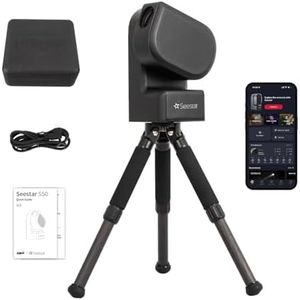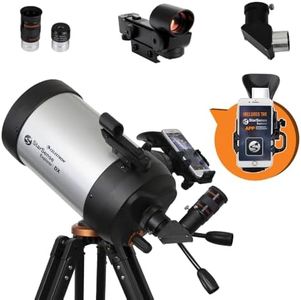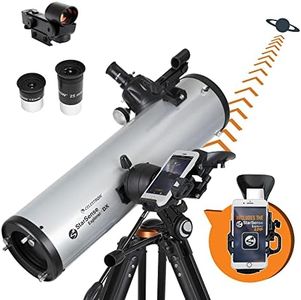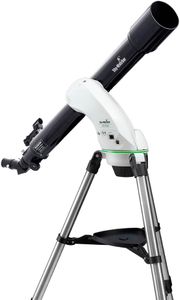We Use CookiesWe use cookies to enhance the security, performance,
functionality and for analytical and promotional activities. By continuing to browse this site you
are agreeing to our privacy policy
6 Best Computerized Telescopes
From leading brands and best sellers available on the web.Buying Guide for the Best Computerized Telescopes
Choosing the right computerized telescope can make stargazing more enjoyable and accessible, especially if you are new to astronomy or want convenience while observing the night sky. It's important to know what features matter most for your needs, whether you are interested in casual viewing, astrophotography, or exploring deep space objects. Understanding the different specifications will help you avoid feeling overwhelmed and allow you to select a telescope that matches your expectations and observing environment.Aperture SizeAperture size refers to the diameter of the telescope’s main lens or mirror, which is the part that gathers light. This is perhaps the most important factor because it directly influences how much detail you can see, how bright objects appear, and how well you can observe faint celestial bodies. Smaller apertures (under 80mm) are lightweight and suitable for beginners or for those who want to view the moon and planets. Medium apertures (80mm-150mm) allow you to see finer details and some deep sky objects, making them good for hobbyists. Large apertures (over 150mm) are best if you want to observe deep space objects and need the best image brightness and detail, though these are usually heavier and less portable. To pick the right one, think about what you want to observe most and whether you’ll travel with your telescope.
Mount TypeThe mount is the base on which the telescope sits, holding your instrument steady and letting you move it. Computerized telescopes usually come with either an alt-azimuth (AZ) or equatorial (EQ) mount, and both can be motorized for automatic tracking of the sky. Alt-azimuth mounts move up/down and left/right, are simple to use, and work well for visual observation. Equatorial mounts are designed to track the motion of the stars more accurately by following the Earth’s rotation, making them better for astrophotography or observing for long periods. When choosing, think about whether you want simplicity for casual viewing (go for AZ) or advanced tracking for photography or serious observation (pick EQ).
Go-To CapabilityGo-To refers to the telescope's ability to automatically locate and track celestial objects using a built-in computer and motor. This is a key benefit of computerized telescopes, making it easy to find thousands of objects without manual star-hopping. Basic Go-To systems offer push-button finding for key planets and stars—ideal for beginners or casual users. More advanced systems can store large databases, connect to phones or apps, and allow for custom tours of the sky, better for hobbyists who want to explore more or learn quickly. You should decide how much you want the telescope to do for you—if you love learning the sky hands-on, simpler interfaces are enough; if you want maximum automation and less effort, opt for more advanced Go-To features.
Optical DesignOptical design describes the way lenses and mirrors are arranged in the telescope. Common types include refractor, reflector, and compound (catadioptric). Refractors use lenses and often provide crisp, high-contrast views, especially for planets; they tend to be lighter but more expensive per inch of aperture. Reflectors use mirrors and offer more aperture for the price, good for deep-sky objects but require more maintenance. Compound telescopes combine lenses and mirrors for versatility, compactness, and ease of use. Consider your interests: refractors are low maintenance and good for planetary viewing, reflectors are cost-effective for deep sky, and compounds offer portability and multi-purpose use.
PortabilityPortability refers to how easy it is to transport and set up your telescope. Computerized telescopes can range from small, tabletop models that are easy to bring outside or travel with, to large, heavy-duty models best suited for stationary setups. Smaller telescopes are perfect if you plan to stargaze from various locations or have limited storage space. Larger and heavier telescopes are better for those with a permanent observing spot and who want maximum capability. Think about where you'll use your telescope—if you want to take it to dark-sky sites or just use it on your balcony, let that guide your choice.
User Interface and SoftwareThe interface is how you control the telescope’s computer—usually via a hand controller, smartphone app, or onboard screen. Some systems are very straightforward, offering simple menus and quick setup, great for beginners who want stress-free use. Others offer detailed programming, alignment routines, or connection to advanced astronomy apps for those wanting more control or integration with other tech. Your familiarity with technology and comfort level with apps or menus should guide what kind of interface is best for you—pick something you find intuitive to ensure you use the telescope often and without frustration.








